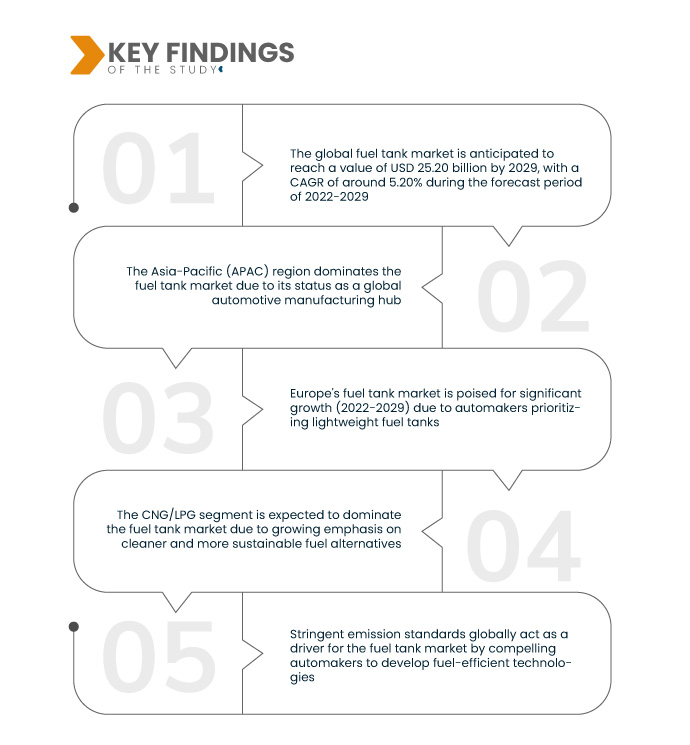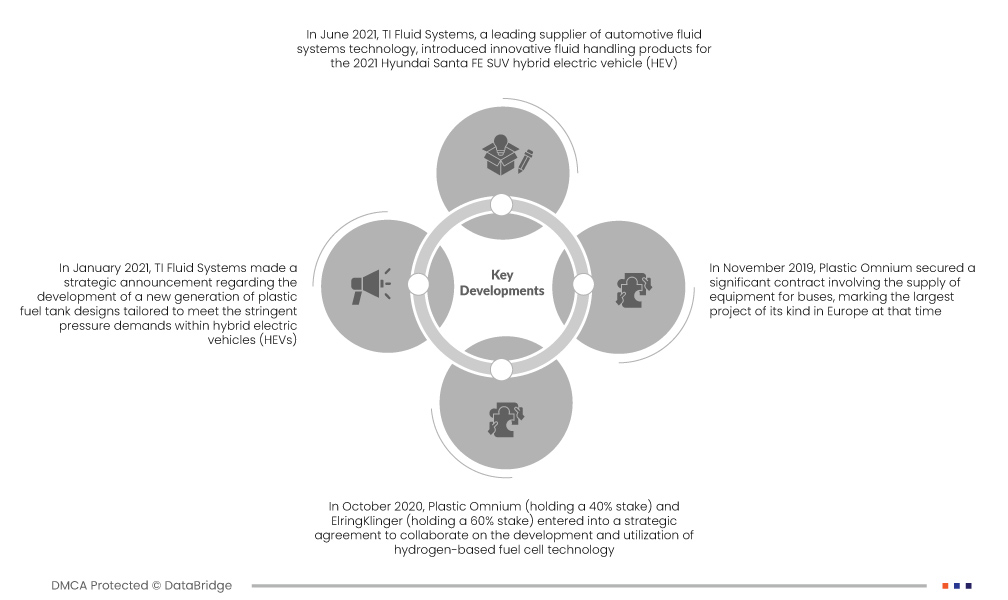The fuel tank directly impacts vehicle performance, safety, and compliance with environmental regulations. Efficient fuel tank designs contribute to overall vehicle light weighting, improving fuel efficiency, and meeting stringent emission standards. With the rise of electric and hybrid vehicles, the market plays a vital role in developing advanced energy storage solutions. Additionally, innovations in fuel tank technologies support global efforts toward sustainable transportation, addressing environmental concerns.
Access full Report @ https://www.databridgemarketresearch.com/reports/global-fuel-tank-market
Data Bridge Market Research analyses the Global Fuel Tank Market was valued at USD 16.80 billion in 2021 and is expected to reach USD 25.20 billion by 2029, registering a CAGR of 5.20% during the forecast period of 2022-2029. The fuel tank market is driven by a rising car production to meet consumer needs, there is a parallel surge in the demand for fuel tanks, and essential components for the vehicles, driving growth in the fuel tank market.
Key Findings of the Study
Increasing government policies and incentives is expected to drive the market's growth rate
Government incentives and policies play a pivotal role in driving the fuel tank market by influencing automotive manufacturing trends. Tax incentives for green vehicles and regulations promoting fuel efficiency incentivize automakers to invest in advanced fuel tank technologies. Manufacturers are compelled to develop lightweight and efficient fuel tanks to meet regulatory standards and qualify for government incentives. This dynamic encourages innovation in fuel tank design, materials, and manufacturing processes, shaping the market landscape and fostering the adoption of environmentally friendly and fuel-efficient vehicles. As a result, government initiatives become a significant driver propelling advancements in the fuel tank market.
Report Scope and Market Segmentation
|
Report Metric
|
Details
|
|
Forecast Period
|
2022 to 2029
|
|
Base Year
|
2021
|
|
Historic Years
|
2020 (Customizable to 2014-2019)
|
|
Quantitative Units
|
Revenue in USD Billion, Volumes in Units, Pricing in USD
|
|
Segments Covered
|
Tank Capacity (Less Than 45 L, 45L -70L, and More Than 70L), Material Type (Plastic, Aluminum, Steel, Others), Weight (Less Than 7KG, 7KG to 10 KG, More Than 70KG), Fuel Type (LPG/CNG, Diesel, Gasoline), Propulsion Type (Natural Gas, Hydrogen, Internal Combustion Engine (ICE), Hybrid), Sales Channel (OEM, Aftermarket), Vehicle Type (Passenger Cars, Light Commercial Vehicle, Heavy Commercial Vehicle, Hybrid Vehicle)
|
|
Countries Covered
|
U.S., Canada, Mexico, Brazil, Argentina, Rest of South America, Germany, Italy, U.K., France, Spain, Netherlands, Belgium, Switzerland, Turkey, Russia, Rest of Europe, Japan, China, India, South Korea, Australia, Singapore, Malaysia, Thailand, Indonesia, Philippines, Rest of Asia-Pacific, Saudi Arabia, U.A.E, South Africa, Egypt, Israel, Rest of Middle East and Africa
|
|
Market Players Covered
|
TI Fluid Systems (U.K.), Yachiyo Industry Co., Ltd. (Japan), Magna International Inc. (Canada), Plastic Omnium (France), Unipres Corporation (U.S.), Kautex (Germany), ContiTech AG (Germany), SMA Serbatoi SpA (Italy), FTS CO.,LTD. (Japan), Crefact Corporation (U.S.), Boyd Welding LLC (U.S.), Elkamet Kunststofftechnik GmbH (Germany), Salzburger Aluminium Group (Austria), Central Precision Limited (U.K.), Arrow Radiators (Melksham) Ltd (U.K.), A. KAYSER AUTOMOTIVE SYSTEMS GmbH (Germany), and PIOLAX, Inc (Japan), among others
|
|
Data Pointers
|
In addition to the market insights such as market value, growth rate, market segments, geographical coverage, market players, and market scenario, the market report curated by the Data Bridge Market Research team includes in-depth expert analysis, import/export analysis, pricing analysis, production consumption analysis, and pestle analysis.
|
Segment Analysis:
The global fuel tank market is segmented on the basis of tank capacity, material type, weight, fuel type, propulsion type, sales channel and vehicle type.
- On the basis of tank capacity, the market is segmented into less than 45 L, 45L -70 L and more than 70 L. Less than 45 L segment is expected to dominate the market with CAGR of 5.5% in the forecast period of 2022-2029. It dominates the market due to the growing demand for compact and fuel-efficient vehicles, as smaller tank capacities align with the trend toward lightweight and eco-friendly designs, meeting the preferences of urban consumers and regulatory standards for fuel efficiency
- On the basis of material type, the market is segmented into plastic, aluminum, steel, and others. The plastic is expected to dominate the market with the CAGR of 5.0%. It dominates the fuel tank market due to its lightweight nature, corrosion resistance, and flexibility in design, contributing to improved fuel efficiency and compliance with stringent emission standards
- On the basis of weight, the market is segmented into less than 7 kg, 7 TO 10 kg, and more than 70 kg. The less than 7 kg segment is expected to dominate the market with a CAGR of 6.8%. It dominates the market due to increasing emphasis on lightweight materials and fuel efficiency in the automotive industry
- On the basis of fuel type, the market is segmented into LPG/CNG, gasoline and diesel. The CNG/LPG segment is expected to dominate the market with a CAGR of 5.3% due to increasing global emphasis on eco-friendly and sustainable fuel options
The CNG/LPG segment of fuel type segment is expected to dominate the global fuel tank market in the forecast period of 2022-2029
The CNG/LPG segment is expected to dominate the fuel tank market with a CAGR of 5.3% the due to the growing emphasis on cleaner and more sustainable fuel alternatives. With increasing environmental concerns and regulatory measures promoting reduced emissions, compressed natural gas (CNG) and liquefied petroleum gas (LPG) have gained popularity as cleaner-burning fuels. This shift is driving the demand for vehicles equipped with CNG/LPG systems, consequently boosting the market for specialized fuel tanks designed to store and transport these alternative fuels.
- On the basis of propulsion type, the market is segmented into internal combustion engine (ICE), natural gas, hydrogen, and hybrid. The natural gas segment is expected to dominate the market with a CAGR of 5.8%. It dominates the market due increasing interest in cleaner and more sustainable energy sources
- On the basis of the sales channel, the market is segmented into OEM and aftermarket. The OEM segment is expected to dominate the market because automakers typically procure fuel tanks directly from manufacturers to integrate them seamlessly into new vehicles during the production process. It is expected to grow with a CAGR of 4.5%
- On the basis of vehicle type, the market is segmented into passenger cars, light commercial vehicle, heavy commercial vehicle and hybrid vehicle. The passenger cars segment is expected to dominate the market with a CAGR of 5.3%. It dominates the market due to the increasing global demand for automobiles, particularly in emerging markets
The passenger cars segment of vehicle type segment is expected to dominate the global fuel tank market during the forecast period 2022-2029
The dominance of the passenger cars segment in the fuel tank market with a CAGR of 5.3% due to the sheer volume of consumer demand for personal transportation. With a growing global population and increasing urbanization, the demand for passenger vehicles, including cars, remains consistently high. Stricter environmental regulations and a shift towards fuel efficiency have also driven innovations in fuel tank technologies for passenger cars, further contributing to their market dominance.
Major Players
Data Bridge Market Research recognizes the following companies as the major global fuel tank market players in global fuel tank market are TI Fluid Systems (U.K.), Yachiyo Industry Co., Ltd. (Japan), Magna International Inc. (Canada), Plastic Omnium (France), Unipres Corporation (U.S.), Kautex (Germany)
Market Developments
- In June 2021, TI Fluid Systems, a leading supplier of automotive fluid systems technology, introduced innovative fluid handling products for the 2021 Hyundai Santa FE SUV hybrid electric vehicle (HEV). These products were specifically designed to enhance fuel systems, showcasing TI Fluid Systems' expertise in optimizing systems with lightweight solutions. The focus on lightweight components aimed to improve the efficiency of the electric vehicle (EV) mode on the Hyundai Santa FE SUV HEV
- In January 2021, TI Fluid Systems made a strategic announcement regarding the development of a new generation of plastic fuel tank designs tailored to meet the stringent pressure demands within hybrid electric vehicles (HEVs). This technology advancement reached a significant milestone with the commencement of volume production in collaboration with Volkswagen China. The plastic fuel tank design was implemented on the Passat and Magotan plug-in hybrid electric vehicle (PHEV) models. The successful launch marked a step forward in addressing the challenges posed by pressure requirements in HEVs, with plans for the adoption of this technology across a broader range of global platforms
- In October 2020, Plastic Omnium (holding a 40% stake) and ElringKlinger (holding a 60% stake) entered into a strategic agreement to collaborate on the development and utilization of hydrogen-based fuel cell technology. This collaboration aimed to leverage the expertise of both companies in advancing fuel cell solutions. The agreement marked a significant initiative toward the exploration and implementation of hydrogen fuel cell technology, highlighting a joint effort to contribute to the evolution of clean and sustainable energy solutions in the automotive sector
- In November 2019, Plastic Omnium secured a significant contract involving the supply of equipment for buses, marking the largest project of its kind in Europe at that time. This strategic initiative contributed significantly to the company's revenue growth. The contract such asly included the provision of various automotive components, potentially encompassing fuel tanks, emissions control systems, or other specialized equipment tailored for buses. The deal not only underscored Plastic Omnium's capabilities in the automotive sector but also positioned the company as a key player in the burgeoning market for bus-related components. Such ventures into diverse automotive segments often enhance a company's overall market presence and financial performance
Regional Analysis
Geographically, the countries covered in the global fuel tank market report are U.S., Canada, Mexico, Brazil, Argentina, Rest of South America, Germany, Italy, U.K., France, Spain, Netherlands, Belgium, Switzerland, Turkey, Russia, Rest of Europe, Japan, China, India, South Korea, Australia, Singapore, Malaysia, Thailand, Indonesia, Philippines, Rest of Asia-Pacific, Saudi Arabia, U.A.E, South Africa, Egypt, Israel, Rest of Middle East and Africa
As per Data Bridge Market Research analysis:
Asia-Pacific is the dominant region in the global fuel tank market during the forecast period 2022-2029
The dominance of the Asia-Pacific (APAC) region in the fuel tank market stems from its role as a global automotive manufacturing hub, particularly in countries such as China, Japan, South Korea, and India. The region's rapid economic development, burgeoning middle-class population, urbanization, and infrastructure projects have led to a substantial increase in the production of passenger vehicles. Government initiatives, favorable regulatory frameworks, and collaborations with global automotive manufacturers further contribute to the growth of the automotive sector in APAC.
Europe is estimated to be the fastest-growing region in the global fuel tank market for the forecast period 2022-2029
The Europe is expected to experience significant growth during the forecast period from 2022 to 2029 due to automakers' heightened focus on adopting lightweight fuel tanks. This emphasis stems from the need to reduce the overall weight of vehicles, a critical strategy in meeting stringent fuel efficiency and emission standards set by European regulatory bodies. As part of a broader trend toward sustainability, technological innovations in materials and manufacturing processes enable the production of lightweight yet durable fuel tanks.
For more detailed information about the global fuel tank market report, click here – https://www.databridgemarketresearch.com/reports/global-fuel-tank-market













